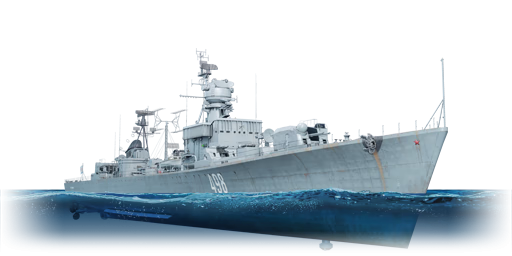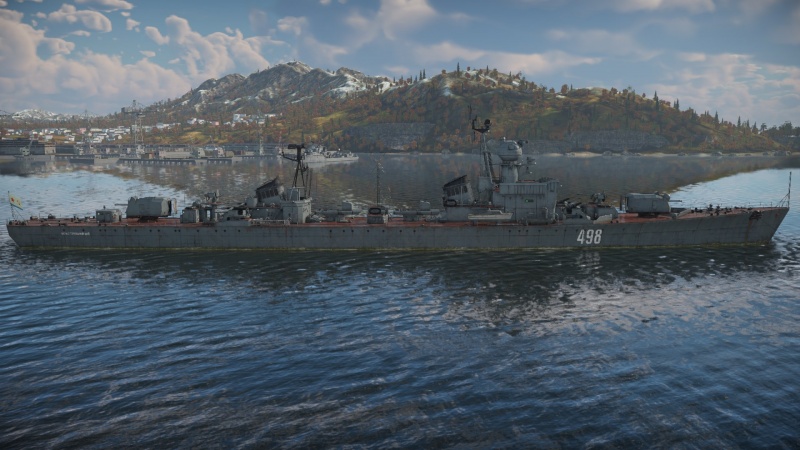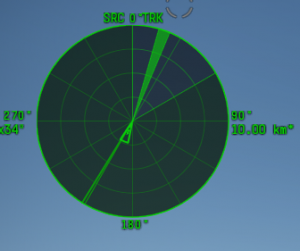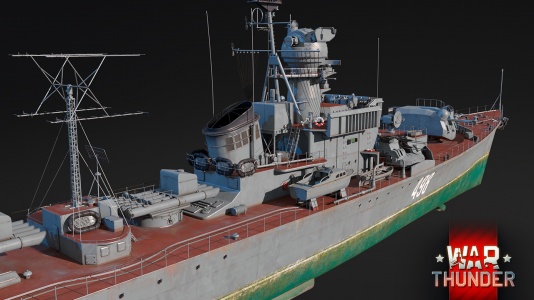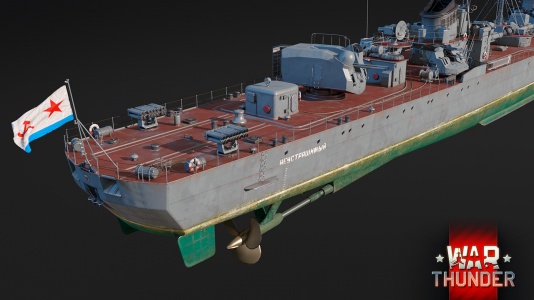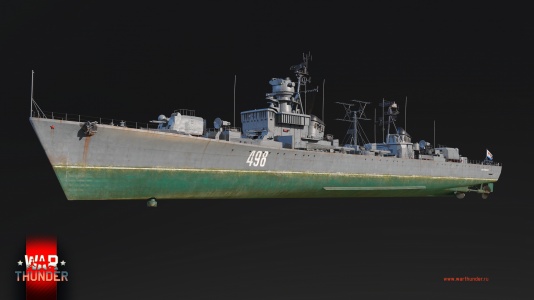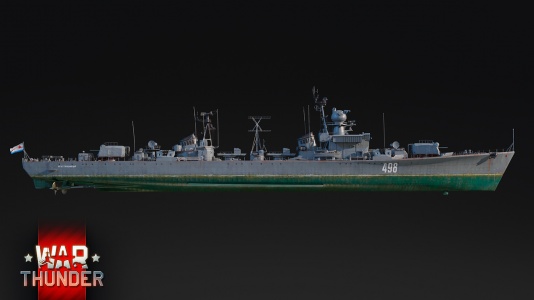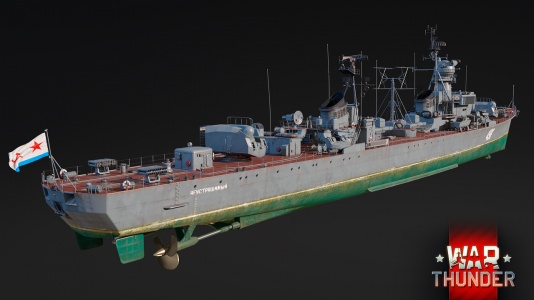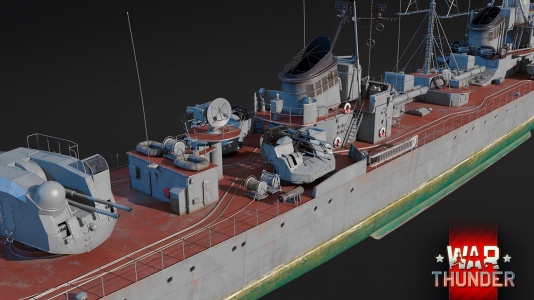Difference between revisions of "Neustrashimy"
(Edits) |
Colok76286 (talk | contribs) (Edits) |
||
| (21 intermediate revisions by 10 users not shown) | |||
| Line 1: | Line 1: | ||
| − | {{Specs-Card|code=ussr_destroyer_pr41_neustrashimy}} | + | {{Specs-Card |
| + | |code=ussr_destroyer_pr41_neustrashimy | ||
| + | |images={{Specs-Card-Image|GarageImage_{{PAGENAME}}.jpg}} | ||
| + | }} | ||
== Description == | == Description == | ||
<!-- ''In the first part of the description, cover the history of the ship's creation and military application. In the second part, tell the reader about using this ship in the game. Add a screenshot: if a beginner player has a hard time remembering vehicles by name, a picture will help them identify the ship in question.'' --> | <!-- ''In the first part of the description, cover the history of the ship's creation and military application. In the second part, tell the reader about using this ship in the game. Add a screenshot: if a beginner player has a hard time remembering vehicles by name, a picture will help them identify the ship in question.'' --> | ||
| − | + | The '''{{Specs|name}}''' was the sole ship of the Project 41 Neustrashimy-class destroyers, the first Soviet post-WWII destroyer design. Neustrashimy was to be a prototype for further series of ships. Unfortunately this never happened as she was deemed too big for serial production. A modified design which resulted in [[Pr.56 (Family)|Project 56 (Kotlin class)]] was chosen instead. The Neustrashimy was also the first Soviet ship to receive a NATO designation as the Tallinn-class. Neustrashimy was laid down on 5th July 1950 and commissioned on 31st January 1955. She was assigned to the Baltic Fleet and served there until 22nd February 1974 when she was decommissioned and sold for scrap. | |
| − | + | ||
| − | The '''{{Specs|name}}''' | + | Neustrashimy was introduced in [[Update 1.97 "Viking Fury"]] as a GE {{ge}} premium. Unusually for a destroyer, her bridge is protected by 20 mm thick antifragmentation armour, and her magazines are under the waterline, making them protected from direct fire unless the shells hit from a distance at an angle. Neustrashimy is also equipped with air search and track radar capable of tracking targets up to 150 km away, alerting captains of any incoming air threat in advance. Her four quadruple 45 mm autocannons coupled with HE-VT shells in the main armament can then make short work of any bomber. Neustrashimy is also equipped with two quintuple 533 mm torpedo launchers firing 53-39 torpedoes with maximum speed of 94 km/h and range of 4 km. |
| + | |||
| + | Neustrashimy was removed from sale due to the [[wt:en/news/6915-development-fleet-research-changes-and-the-first-battleships|fleet research changes]] in [[Update "New Power"]]. It was briefly made available for purchase with Golden Eagles {{ge}} for the [[wt:ru/news/15831-akciya-den-vmf-rossii-ru|2022]], [[wt:en/news/8377-special-stroyny-and-neustrashimy-for-golden-eagles-en|2023]], and [[wt:ru/news/16914-akcia-den-vmf-rossii-dekal-strojnyj-i-neustrasimyj-za-zo-ru|2024]] "Russian Navy Day" mini-events. | ||
== General info == | == General info == | ||
=== Survivability and armour === | === Survivability and armour === | ||
| − | ''Talk about the vehicle's armour. Note the most well-defended and most vulnerable zones, e.g. the ammo magazine. Evaluate the composition of components and assemblies responsible for movement and manoeuvrability. Evaluate the survivability of the primary and secondary armaments separately. Don't forget to mention the size of the crew, which plays an important role in fleet mechanics. Save tips on preserving survivability for the "Usage in battles" section. If necessary, use a graphical template to show the most well-protected or most vulnerable points in the armour.'' | + | {{Specs-Fleet-Armour}} |
| + | <!-- ''Talk about the vehicle's armour. Note the most well-defended and most vulnerable zones, e.g. the ammo magazine. Evaluate the composition of components and assemblies responsible for movement and manoeuvrability. Evaluate the survivability of the primary and secondary armaments separately. Don't forget to mention the size of the crew, which plays an important role in fleet mechanics. Save tips on preserving survivability for the "Usage in battles" section. If necessary, use a graphical template to show the most well-protected or most vulnerable points in the armour.'' --> | ||
| + | As the father of the Pr. 56, the armour is lacklustre and will be only able to withstand low calibre fire and small amounts of explosive fragmentation. The bridge, turrets and smoke funnels have 10 mm anti fragmentation armour, meaning they will be prompt to be damaged or even destroyed by 12.7 mm or 20 mm armour piercing rounds. When it comes to components, it is almost impossible to make an ammo explosion in the Pr. 41 as the ammunition is below the waterline, meaning only armour piercing rounds impacting below the waterline or torpedoes will be able to create an ammo explosion. When it comes to air threats (machine gun strafes, rockets, bombs), the Pr. 41 will be able to survive them with some exceptions of bombs. Bombs that land in a 0-40 m radius of the ships can cause fatal damage (it will also depend on the type of bomb, weight, TNT equivalent, etc). | ||
=== Mobility === | === Mobility === | ||
| − | ''Write about the ship's mobility. Evaluate its power and manoeuvrability, rudder rerouting speed, stopping speed at full tilt, with its maximum forward and reverse speed.'' | + | {{Specs-Fleet-Mobility}} |
| + | <!-- ''Write about the ship's mobility. Evaluate its power and manoeuvrability, rudder rerouting speed, stopping speed at full tilt, with its maximum forward and reverse speed.'' --> | ||
| + | The Pr. 41, as a "modern" destroyer of 1955, changes completely the doctrine of previous destroyers, meaning it compensates armour with speed. It is not able to reach speeds like the Pr. 56 due to being longer and heavier while using the same engines. However, it can reach speeds of ~65 km/h, making it terrifyingly fast for a ship of its size and firepower, almost on par with coastal fleet frigates and sub-chasers ([[Albatros]], [[SKR-7]], etc). It is more than capable of reaching the battlefield faster than other destroyers and will outrun cruisers and battleships. When it comes to manoeuvrability, it leaves nothing to expect. It is able to do tight turns (relatively tight turns but with greater speed than other destroyers) as well as accelerate and decelerate quickly. | ||
{{NavalMobility}} | {{NavalMobility}} | ||
| + | |||
| + | === Modifications and economy === | ||
| + | {{Specs-Economy}} | ||
== Armament == | == Armament == | ||
| + | {{Specs-Fleet-Armaments}} | ||
=== Primary armament === | === Primary armament === | ||
| + | {{Specs-Fleet-Primary}} | ||
| + | <!-- ''Provide information about the characteristics of the primary armament. Evaluate their efficacy in battle based on their reload speed, ballistics and the capacity of their shells. Add a link to the main article about the weapon: <code><nowiki>{{main|Weapon name (calibre)}}</nowiki></code>. Broadly describe the ammunition available for the primary armament, and provide recommendations on how to use it and which ammunition to choose.'' --> | ||
{{main|130 mm/58 SM-2-1 (130 mm)}} | {{main|130 mm/58 SM-2-1 (130 mm)}} | ||
| − | + | The Pr. 41 is armed with 4 x 130 mm/58 SM-2-1 semi automatic cannons divided into 2 dual-mount turrets, capable of decimating enemy vessels in seconds, including heavy cruisers. The 130 mm cannons have access to 3 types of shells, HE, SAPCBC and HE-VT. It is recommended that the captain gets access to the SAPCBC as it has the penetration of an APCBC shell but the explosive power of an HE shell. HE-VT are an extra when it comes to air defence. They will decimate any enemy plane with an airbust but they are only recommended to be used when attacking low speed aircraft (like bombers) at long ranges (past 10 km) as the relative low fire rate (15 RPM) and targeting speed will cause issues engaging faster aircraft (fighters or even attackers). It should be noted the 130 mm can be used with the tracking radar the destroyer has. | |
| + | |||
| + | {{:130 mm/58 SM-2-1 (130 mm)/Ammunition|130 mm OF-42 HE, 130 mm PB-42 SAP, 130 mm ZS-42R HE-VT}} | ||
=== Secondary armament === | === Secondary armament === | ||
| + | {{Specs-Fleet-Secondary}} | ||
| + | <!-- ''Some ships are fitted with weapons of various calibres. Secondary armaments are defined as weapons chosen with the control <code>Select secondary weapon</code>. Evaluate the secondary armaments and give advice on how to use them. Describe the ammunition available for the secondary armament. Provide recommendations on how to use them and which ammunition to choose. Remember that any anti-air armament, even heavy calibre weapons, belong in the next section. If there is no secondary armament, remove this section.'' --> | ||
{{main|45 mm/89 SM-20-ZIF (45 mm)}} | {{main|45 mm/89 SM-20-ZIF (45 mm)}} | ||
| − | + | The Pr. 41 is armed with 16 x 45 mm/89 SM-20-ZIF automatic cannons divided into 4 quad-mounted turrets, capable of shredding anything but cruisers. It should be noted that the turrets displacement is different to the Pr. 56. While the Pr. 56 has the turrets in a cross shape (+, a turret in front of the bridge behind the bow turret, two turrets parallel to the bridge and a final turret behind the bridge), the Pr. 41 have this turrets parallel (=) to the ship's bridge. This displacement, while being a minor difference, change how the 45 mm can be used. The parallel arrange makes the 45 mm capable of firing completely in front or behind of the ship without having a dead zone due to 130 mm turrets blocking your LoS (line of sight). The 45 mm cannons only have access to HE, meaning they will do little to no damage to heavily armoured targets even at point blank range. The 45 mm are your main line of defence against light and medium armoured vessels as the fast rate of fire (0.4-second reload) will cause fatal damage with even just one burst. They are also your main line of defence against any aircraft at any range from 0 to 10 km (AI gunners will not engage targets past ~10 km. It is also the max range of the tracking radar). They will destroy incoming enemy aircraft within seconds. The captain is able to control them manually and use the tracking radar to engage air targets manually. It is recommended to let the AI gunners engage the targets when the threat is closer than 5 km as the captain will be able to focus on more threatening enemies (other vessels or even aircraft). When letting AI gunners engage targets, be aware of which targeting setting is set (airborne and surface, airborne, surface, none) as each turret will only engage one target at a time. | |
| − | + | * '''Universal:''' {{Annotation|HEF|High-explosive fragmentation}}{{-}}{{Annotation|HEF-T*|High-explosive fragmentation tracer (self-destroying)}} | |
| − | {{ | ||
| − | + | {{:45 mm/89 SM-20-ZIF (45 mm)/Ammunition|HEF-T*, HEF}} | |
| − | === | + | === Additional armament === |
| − | {{main|RBU-2500}} | + | {{Specs-Fleet-Additional}} |
| + | <!-- ''Describe the available additional armaments of the ship: depth charges, mines, torpedoes. Talk about their positions, available ammunition and launch features such as dead zones of torpedoes. If there is no additional armament, remove this section.'' --> | ||
| + | {{main|53-39 (533 mm)|RBU-2500}} | ||
| − | + | The Pr. 41 is armed with 2 5-tube torpedo launchers. Contrary to the Pr. 56, the Pr. 41 is armed with the 53-39 torpedoes and not 53-56 torpedoes. They have a max range of 4 km (10 km with torpedo mode) and can be used at almost point blank, the torpedo must travel 50 m at minimum to be armed (most of the time "point blank" engagements will be between 100-500 m). Depending on the map, game mode and captain's discretion, torpedo depth can be adjusted in order to achieve multiple tasks. | |
| − | + | '''1-meter depth''' - This is the most universal depth used for all types of engagements, being in deep water or at shallow waters. This depth is capable of hitting all sorts of vessels, including PT boats. The main downside is that enemy ships can see the water trail made by the torpedo which can make enemy vessels evade or fire at the torpedo. | |
| − | '' | + | |
| + | '''4-meter depth''' - This is the recommended depth when on deep water trying to do long range sneaky engagements to big ships (most of them have bulkheads more than 4 m under the waterline). This is one of the riskier techniques as there is no way to launch them on shallow waters (most shallow water maps have water depth of 2-3 m). Only the captain and the team will be able to see the torpedo symbol while traveling close to them and it will not leave any visible water trail compared to the 1 meter depth torpedo. | ||
| + | |||
| + | The Pr. 41 rounds off the armament with four RBU-2500 anti-submarine rocket launchers, each carrying 12 rockets to total 48. As being rockets they have a limited effective engagement range, high arcs of fire and are very hard to aim in conjunction with primary weapons, however should a small boat decide to get too close or should you decide to engage a target at point-blank range, the barrage of 26 kg warheads smashing into the superstructure and hull of the hostile ship will almost certainly cripple it, if not outright sink it. | ||
| + | |||
| + | === Radar === | ||
| + | [[File:Radar interface Pr. 35.png|thumb|Pr. 41 radar display.<br>Dark green: within targeting radar angle<br>Light green: targeting radar dead zone]] | ||
| + | The Pr. 41 has access to a Fut-N air/surface search radar and Sfera-56 fire control radar, unique for this vessel. The Fut-N is located on top of the mizzen mast (rear mast). Sfera-56 in front of the main mast is located on top of the bridge (refer to picture). Enemy pilots are often unaware of the presence of the radar as they are uncommon in-game, use surprise to your advantage. Radars can give you a huge advantage with situational awareness as no plane will be able to catch you unsuspected. Be aware of radar interference (mountains, trees, tall structures in general) as they will affect both your search and tracking radar. There are blind spots with the radars which pilots can exploit but most of them will not do so as radars are uncommon in battles. As previously stated, tracking radar can be used to manually engage targets. It is recommended to use tracking radar when engaging immediate threats the gunners are not engaging or low speed flying aircraft at long ranges (bombers). Most of the time, the use of tracking radar will not be necessary as gunners will take care of aircraft while the captain is engaging enemy vessels. | ||
| − | + | {| class="wikitable" style="text-align:center" | |
| − | {| class="wikitable" | + | ! colspan="4" |Fut-N - Air/surface Search Radar |
| − | |||
| − | |||
| − | |||
| − | ! colspan=" | ||
|- | |- | ||
| − | | | + | !{{Annotation|Maximum<br/>Detection<br/>Range|The maximum possible range at which a target can be detected}} |
| − | | | + | !{{Annotation|Guaranteed<br/>Detection<br/>Range|The range, below which, detection of a target is practically guaranteed}} |
| − | | | + | !{{Annotation|Max Azimuth<br/>Scan Angle|How far to each side the radar can scan (widest search mode)}} |
| − | | | + | !{{Annotation|Max Elevation<br/>Scan Angle|How far up and down the radar can scan (widest search mode)}} |
| − | | | ||
| − | | | ||
| − | | | ||
|- | |- | ||
| − | | | + | | 120,000 m || 10,000 m || 360° || 0°/+75° |
| − | | | ||
| − | | | ||
| − | | | ||
| − | | | ||
| − | | | ||
| − | | | ||
|- | |- | ||
| − | | | + | ! colspan="4" |Sfera-56 - Fire Control Radar |
| − | |||
| − | |||
| − | |||
| − | |||
| − | |||
| − | |||
|- | |- | ||
| − | | | + | !{{Annotation|Maximum<br/>Tracking<br/>Range|The maximum range at which a target can be tracked}} |
| − | | | + | !{{Annotation|Minimum<br/>Tracking<br/>Range|The range below which targets cannot be tracked by the radar}} |
| − | | | + | !{{Annotation|Azimuth Tracking<br/>Angle|How far to each side the radar can track a target}} |
| − | | | + | !{{Annotation|Elevation Tracking<br/>Angle|How far up and down the radar can track a target}} |
| − | | | ||
| − | |||
| − | | | ||
| − | | | ||
| − | |||
|- | |- | ||
| + | | 10,000 m || 100 m || 315° || 0°/+80° | ||
|} | |} | ||
| + | |||
| + | == Usage in battles == | ||
| + | <!-- ''Describe the technique of using this ship, the characteristics of her use in a team and tips on strategy. Abstain from writing an entire guide – don't try to provide a single point of view, but give the reader food for thought. Talk about the most dangerous opponents for this vehicle and provide recommendations on fighting them. If necessary, note the specifics of playing with this vehicle in various modes (AB, RB, SB).'' --> | ||
| + | The Pr. 41 is a Cold War destroyer and thus, it should not be used as a WW2 destroyer as the armour is lacklustre and RPM is limited compared to some cruisers and destroyers. Thus, the Pr. 41 should be used as a support and anti-air ship. The powerful 130 mm are able to decimate destroyers and even cruisers in minutes, specially if the SAP round is used. The high speed and agility make it a decent runner when facing enemy ships and capping points. The torpedo can be formidable if used correctly, not only for the fact they are able to destroy whatever it hits but also because they are hard to aim due to the distances the Pr. 41 has to navigate in order to get into a decent launch distance. The 45 mm should be used as secondary weapons for everything but sinking heavily armoured ships. They are able to decimate light vessels in seconds as well as planes. For this same reason, the Pr. 41 should be used as an anti-air flagship as it is able to detect and engage enemy planes in a range of 130 km. Absolutely no aircraft will surprise the Pr. 41 while the search radar is active. The Pr. 41, when used in Enduring Confrontation events, is the most reliable and "Jack-of-all-trades" ship seen in-game. Not only because it is able to dominate the skies but also because it is able to decimate enemy convoys within seconds with the firepower and torpedoes, specially if said convoys are unarmed cargo ships. | ||
| + | |||
| + | Absolutely no battleship should be engaged with the 130 mm as they are mediocre and most of the time useless. However, they can damage and destroy outer modules like turrets, bridge, and smoke funnels, and can start fires. When facing heavily armoured vessels, torpedoes are a must as they will be your only reliable weapon against them. The Pr. 41 should zig-zag when being fired at as a single salvo is more than enough to instantly destroy you. Zig-zagging reduces the chances the enemy has to hit and due to the long reload, the Pr. 41 is able to close distance and fire torpedoes. | ||
=== Pros and cons === | === Pros and cons === | ||
| Line 96: | Line 106: | ||
== History == | == History == | ||
| − | ''Describe the history of the creation and combat usage of the ship in more detail than in the introduction. If the historical reference turns out to be too long, take it to a separate article, taking a link to the article about the ship and adding a block "/History" (example: <nowiki>https://wiki.warthunder.com/(Ship-name)/History</nowiki>) and add a link to it here using the <code>main</code> template. Be sure to reference text and sources by using <code><nowiki><ref></ref></nowiki></code>, as well as adding them at the end of the article with <code><nowiki><references /></nowiki></code>. This section may also include the ship's dev blog entry (if applicable) and the in-game encyclopedia description (under <code><nowiki>=== In-game description ===</nowiki></code>, also if applicable).'' | + | <!-- ''Describe the history of the creation and combat usage of the ship in more detail than in the introduction. If the historical reference turns out to be too long, take it to a separate article, taking a link to the article about the ship and adding a block "/History" (example: <nowiki>https://wiki.warthunder.com/(Ship-name)/History</nowiki>) and add a link to it here using the <code>main</code> template. Be sure to reference text and sources by using <code><nowiki><ref></ref></nowiki></code>, as well as adding them at the end of the article with <code><nowiki><references /></nowiki></code>. This section may also include the ship's dev blog entry (if applicable) and the in-game encyclopedia description (under <code><nowiki>=== In-game description ===</nowiki></code>, also if applicable).'' --> |
| + | |||
| + | === [[wt:en/news/6649-development-the-neustrashimy-destroyer-a-superdestroyer-en|Devblog]] === | ||
| + | On January 26th, 1952, a Project 41 destroyer named Andrey Aleksandrovich Zhdanov embarked on sea trials from the Leningrad Shipyard. It was the first of more than a hundred planned ships that were intended for operation in distant maritime zones. | ||
| + | |||
| + | But this impressive major ship series did not see the light of day, and not because the ship proved to be bad. In fact, it was the opposite! The Neustrashimy was so "stuffed" with multiple innovations that it proved to be too complex for the shipbuilding enterprises of the time, as well as for its operators, the navy. For this reason, the ship was converted into a platform for testing various naval innovations and modernisations. In 1960, one of these innovations practically doubled the number of 45 mm automatic anti-aircraft guns. | ||
== Media == | == Media == | ||
| − | ''Excellent additions to the article would be video guides, screenshots from the game, and photos.'' | + | <!-- ''Excellent additions to the article would be video guides, screenshots from the game, and photos.'' --> |
| + | |||
| + | ;Skins | ||
| + | * [https://live.warthunder.com/feed/camouflages/?vehicle=ussr_destroyer_pr41_neustrashimy Skins and camouflages for the {{PAGENAME}} from live.warthunder.com.] | ||
| + | |||
| + | ;Images | ||
| + | <gallery mode="packed" heights="200"> | ||
| + | File:PR.41 Neustrashimy WTWallpaper 01.jpg| | ||
| + | File:PR.41 Neustrashimy WTWallpaper 02.jpg| | ||
| + | File:PR.41 Neustrashimy WTWallpaper 03.jpg| | ||
| + | File:PR.41 Neustrashimy WTWallpaper 04.jpg| | ||
| + | File:PR.41 Neustrashimy WTWallpaper 05.jpg| | ||
| + | File:PR.41 Neustrashimy WTWallpaper 06.jpg| | ||
| + | </gallery> | ||
== See also == | == See also == | ||
''Links to articles on the War Thunder Wiki that you think will be useful for the reader, for example:'' | ''Links to articles on the War Thunder Wiki that you think will be useful for the reader, for example:'' | ||
| + | |||
* ''reference to the series of the ship;'' | * ''reference to the series of the ship;'' | ||
* ''links to approximate analogues of other nations and research trees.'' | * ''links to approximate analogues of other nations and research trees.'' | ||
| Line 109: | Line 138: | ||
<!-- ''Paste links to sources and external resources, such as:'' | <!-- ''Paste links to sources and external resources, such as:'' | ||
* ''topic on the official game forum;'' | * ''topic on the official game forum;'' | ||
| − | |||
* ''other literature.'' --> | * ''other literature.'' --> | ||
* [[wt:en/news/6649-development-the-neustrashimy-destroyer-a-superdestroyer-en|[Devblog] The Neustrashimy destroyer: a "superdestroyer"]] | * [[wt:en/news/6649-development-the-neustrashimy-destroyer-a-superdestroyer-en|[Devblog] The Neustrashimy destroyer: a "superdestroyer"]] | ||
| + | {{ShipManufacturer Zhdanov Shipyard}} | ||
{{USSR destroyers}} | {{USSR destroyers}} | ||
{{USSR premium ships}} | {{USSR premium ships}} | ||
Latest revision as of 12:13, 20 August 2024
Contents
Description
The Pr. 41, Neustrashimy, 1960 was the sole ship of the Project 41 Neustrashimy-class destroyers, the first Soviet post-WWII destroyer design. Neustrashimy was to be a prototype for further series of ships. Unfortunately this never happened as she was deemed too big for serial production. A modified design which resulted in Project 56 (Kotlin class) was chosen instead. The Neustrashimy was also the first Soviet ship to receive a NATO designation as the Tallinn-class. Neustrashimy was laid down on 5th July 1950 and commissioned on 31st January 1955. She was assigned to the Baltic Fleet and served there until 22nd February 1974 when she was decommissioned and sold for scrap.
Neustrashimy was introduced in Update 1.97 "Viking Fury" as a GE ![]() premium. Unusually for a destroyer, her bridge is protected by 20 mm thick antifragmentation armour, and her magazines are under the waterline, making them protected from direct fire unless the shells hit from a distance at an angle. Neustrashimy is also equipped with air search and track radar capable of tracking targets up to 150 km away, alerting captains of any incoming air threat in advance. Her four quadruple 45 mm autocannons coupled with HE-VT shells in the main armament can then make short work of any bomber. Neustrashimy is also equipped with two quintuple 533 mm torpedo launchers firing 53-39 torpedoes with maximum speed of 94 km/h and range of 4 km.
premium. Unusually for a destroyer, her bridge is protected by 20 mm thick antifragmentation armour, and her magazines are under the waterline, making them protected from direct fire unless the shells hit from a distance at an angle. Neustrashimy is also equipped with air search and track radar capable of tracking targets up to 150 km away, alerting captains of any incoming air threat in advance. Her four quadruple 45 mm autocannons coupled with HE-VT shells in the main armament can then make short work of any bomber. Neustrashimy is also equipped with two quintuple 533 mm torpedo launchers firing 53-39 torpedoes with maximum speed of 94 km/h and range of 4 km.
Neustrashimy was removed from sale due to the fleet research changes in Update "New Power". It was briefly made available for purchase with Golden Eagles ![]() for the 2022, 2023, and 2024 "Russian Navy Day" mini-events.
for the 2022, 2023, and 2024 "Russian Navy Day" mini-events.
General info
Survivability and armour
As the father of the Pr. 56, the armour is lacklustre and will be only able to withstand low calibre fire and small amounts of explosive fragmentation. The bridge, turrets and smoke funnels have 10 mm anti fragmentation armour, meaning they will be prompt to be damaged or even destroyed by 12.7 mm or 20 mm armour piercing rounds. When it comes to components, it is almost impossible to make an ammo explosion in the Pr. 41 as the ammunition is below the waterline, meaning only armour piercing rounds impacting below the waterline or torpedoes will be able to create an ammo explosion. When it comes to air threats (machine gun strafes, rockets, bombs), the Pr. 41 will be able to survive them with some exceptions of bombs. Bombs that land in a 0-40 m radius of the ships can cause fatal damage (it will also depend on the type of bomb, weight, TNT equivalent, etc).
Mobility
The Pr. 41, as a "modern" destroyer of 1955, changes completely the doctrine of previous destroyers, meaning it compensates armour with speed. It is not able to reach speeds like the Pr. 56 due to being longer and heavier while using the same engines. However, it can reach speeds of ~65 km/h, making it terrifyingly fast for a ship of its size and firepower, almost on par with coastal fleet frigates and sub-chasers (Albatros, SKR-7, etc). It is more than capable of reaching the battlefield faster than other destroyers and will outrun cruisers and battleships. When it comes to manoeuvrability, it leaves nothing to expect. It is able to do tight turns (relatively tight turns but with greater speed than other destroyers) as well as accelerate and decelerate quickly.
| Mobility Characteristics | |||
|---|---|---|---|
| Game Mode | Upgrade Status | Maximum Speed (km/h) | |
| Forward | Reverse | ||
| AB | |||
| Upgraded | 76 | 26 | |
| RB/SB | |||
| Upgraded | 62 | 22 | |
Modifications and economy
Armament
Primary armament
The Pr. 41 is armed with 4 x 130 mm/58 SM-2-1 semi automatic cannons divided into 2 dual-mount turrets, capable of decimating enemy vessels in seconds, including heavy cruisers. The 130 mm cannons have access to 3 types of shells, HE, SAPCBC and HE-VT. It is recommended that the captain gets access to the SAPCBC as it has the penetration of an APCBC shell but the explosive power of an HE shell. HE-VT are an extra when it comes to air defence. They will decimate any enemy plane with an airbust but they are only recommended to be used when attacking low speed aircraft (like bombers) at long ranges (past 10 km) as the relative low fire rate (15 RPM) and targeting speed will cause issues engaging faster aircraft (fighters or even attackers). It should be noted the 130 mm can be used with the tracking radar the destroyer has.
| Penetration statistics | |||||||
|---|---|---|---|---|---|---|---|
| Ammunition | Type of warhead |
Penetration @ 0° Angle of Attack (mm) | |||||
| 1,000 m | 2,500 m | 5,000 m | 7,500 m | 10,000 m | 15,000 m | ||
| OF-42 HE | HE | 37 | 37 | 37 | 37 | 37 | 37 |
| PB-42 SAP | SAPCBC | 204 | 174 | 134 | 104 | 82 | 57 |
| ZS-42R HE-VT | HE-VT | 35 | 35 | 35 | 35 | 35 | 35 |
| Shell details | ||||||||||||
|---|---|---|---|---|---|---|---|---|---|---|---|---|
| Ammunition | Type of warhead |
Velocity (m/s) |
Projectile mass (kg) |
Fuse delay (s) |
Fuse sensitivity (mm) |
Explosive mass (TNT equivalent) (kg) |
Ricochet | |||||
| 0% | 50% | 100% | ||||||||||
| OF-42 HE | HE | 950 | 33.4 | 0 | 0.1 | 3.83 | 79° | 80° | 81° | |||
| PB-42 SAP | SAPCBC | 950 | 33.4 | 0.04 | 5 | 2.21 | 48° | 63° | 71° | |||
| Proximity-fused shell details | ||||||||||||
|---|---|---|---|---|---|---|---|---|---|---|---|---|
| Ammunition | Type of warhead |
Velocity (m/s) |
Projectile mass (kg) |
Fuse delay (m) |
Fuse sensitivity (mm) |
Arming distance (m) |
Trigger radius (m) |
Explosive mass (TNT equivalent) (kg) |
Ricochet | |||
| 0% | 50% | 100% | ||||||||||
| ZS-42R HE-VT | HE-VT | 955 | 33.08 | 0 | 0.1 | 240 | 16 | 3 | 79° | 80° | 81° | |
Secondary armament
The Pr. 41 is armed with 16 x 45 mm/89 SM-20-ZIF automatic cannons divided into 4 quad-mounted turrets, capable of shredding anything but cruisers. It should be noted that the turrets displacement is different to the Pr. 56. While the Pr. 56 has the turrets in a cross shape (+, a turret in front of the bridge behind the bow turret, two turrets parallel to the bridge and a final turret behind the bridge), the Pr. 41 have this turrets parallel (=) to the ship's bridge. This displacement, while being a minor difference, change how the 45 mm can be used. The parallel arrange makes the 45 mm capable of firing completely in front or behind of the ship without having a dead zone due to 130 mm turrets blocking your LoS (line of sight). The 45 mm cannons only have access to HE, meaning they will do little to no damage to heavily armoured targets even at point blank range. The 45 mm are your main line of defence against light and medium armoured vessels as the fast rate of fire (0.4-second reload) will cause fatal damage with even just one burst. They are also your main line of defence against any aircraft at any range from 0 to 10 km (AI gunners will not engage targets past ~10 km. It is also the max range of the tracking radar). They will destroy incoming enemy aircraft within seconds. The captain is able to control them manually and use the tracking radar to engage air targets manually. It is recommended to let the AI gunners engage the targets when the threat is closer than 5 km as the captain will be able to focus on more threatening enemies (other vessels or even aircraft). When letting AI gunners engage targets, be aware of which targeting setting is set (airborne and surface, airborne, surface, none) as each turret will only engage one target at a time.
- Universal: HEF · HEF-T*
| Penetration statistics | |||||||
|---|---|---|---|---|---|---|---|
| Ammunition | Penetration @ 0° Angle of Attack (mm) | ||||||
| 100 m | 1,000 m | 2,000 m | 3,000 m | 4,000 m | 5,000 m | ||
| HEF-T* | 4 | 4 | 4 | 4 | 4 | 4 | |
| HEF | 4 | 4 | 4 | 4 | 4 | 4 | |
| Shell details | ||||||||||||
|---|---|---|---|---|---|---|---|---|---|---|---|---|
| Ammunition | Velocity (m/s) |
Projectile mass (kg) |
Fuse delay (m) |
Fuse sensitivity (mm) |
Explosive mass (TNT equivalent) (g) |
Ricochet | ||||||
| 0% | 50% | 100% | ||||||||||
| HEF-T* | 1,080 | 1.41 | 0 | 0.1 | 92.4 | 79° | 80° | 81° | ||||
| HEF | 1,080 | 1.41 | 0 | 0.1 | 83.16 | 79° | 80° | 81° | ||||
Additional armament
The Pr. 41 is armed with 2 5-tube torpedo launchers. Contrary to the Pr. 56, the Pr. 41 is armed with the 53-39 torpedoes and not 53-56 torpedoes. They have a max range of 4 km (10 km with torpedo mode) and can be used at almost point blank, the torpedo must travel 50 m at minimum to be armed (most of the time "point blank" engagements will be between 100-500 m). Depending on the map, game mode and captain's discretion, torpedo depth can be adjusted in order to achieve multiple tasks.
1-meter depth - This is the most universal depth used for all types of engagements, being in deep water or at shallow waters. This depth is capable of hitting all sorts of vessels, including PT boats. The main downside is that enemy ships can see the water trail made by the torpedo which can make enemy vessels evade or fire at the torpedo.
4-meter depth - This is the recommended depth when on deep water trying to do long range sneaky engagements to big ships (most of them have bulkheads more than 4 m under the waterline). This is one of the riskier techniques as there is no way to launch them on shallow waters (most shallow water maps have water depth of 2-3 m). Only the captain and the team will be able to see the torpedo symbol while traveling close to them and it will not leave any visible water trail compared to the 1 meter depth torpedo.
The Pr. 41 rounds off the armament with four RBU-2500 anti-submarine rocket launchers, each carrying 12 rockets to total 48. As being rockets they have a limited effective engagement range, high arcs of fire and are very hard to aim in conjunction with primary weapons, however should a small boat decide to get too close or should you decide to engage a target at point-blank range, the barrage of 26 kg warheads smashing into the superstructure and hull of the hostile ship will almost certainly cripple it, if not outright sink it.
Radar
The Pr. 41 has access to a Fut-N air/surface search radar and Sfera-56 fire control radar, unique for this vessel. The Fut-N is located on top of the mizzen mast (rear mast). Sfera-56 in front of the main mast is located on top of the bridge (refer to picture). Enemy pilots are often unaware of the presence of the radar as they are uncommon in-game, use surprise to your advantage. Radars can give you a huge advantage with situational awareness as no plane will be able to catch you unsuspected. Be aware of radar interference (mountains, trees, tall structures in general) as they will affect both your search and tracking radar. There are blind spots with the radars which pilots can exploit but most of them will not do so as radars are uncommon in battles. As previously stated, tracking radar can be used to manually engage targets. It is recommended to use tracking radar when engaging immediate threats the gunners are not engaging or low speed flying aircraft at long ranges (bombers). Most of the time, the use of tracking radar will not be necessary as gunners will take care of aircraft while the captain is engaging enemy vessels.
| Fut-N - Air/surface Search Radar | |||
|---|---|---|---|
| Maximum Detection Range |
Guaranteed Detection Range |
Max Azimuth Scan Angle |
Max Elevation Scan Angle |
| 120,000 m | 10,000 m | 360° | 0°/+75° |
| Sfera-56 - Fire Control Radar | |||
| Maximum Tracking Range |
Minimum Tracking Range |
Azimuth Tracking Angle |
Elevation Tracking Angle |
| 10,000 m | 100 m | 315° | 0°/+80° |
Usage in battles
The Pr. 41 is a Cold War destroyer and thus, it should not be used as a WW2 destroyer as the armour is lacklustre and RPM is limited compared to some cruisers and destroyers. Thus, the Pr. 41 should be used as a support and anti-air ship. The powerful 130 mm are able to decimate destroyers and even cruisers in minutes, specially if the SAP round is used. The high speed and agility make it a decent runner when facing enemy ships and capping points. The torpedo can be formidable if used correctly, not only for the fact they are able to destroy whatever it hits but also because they are hard to aim due to the distances the Pr. 41 has to navigate in order to get into a decent launch distance. The 45 mm should be used as secondary weapons for everything but sinking heavily armoured ships. They are able to decimate light vessels in seconds as well as planes. For this same reason, the Pr. 41 should be used as an anti-air flagship as it is able to detect and engage enemy planes in a range of 130 km. Absolutely no aircraft will surprise the Pr. 41 while the search radar is active. The Pr. 41, when used in Enduring Confrontation events, is the most reliable and "Jack-of-all-trades" ship seen in-game. Not only because it is able to dominate the skies but also because it is able to decimate enemy convoys within seconds with the firepower and torpedoes, specially if said convoys are unarmed cargo ships.
Absolutely no battleship should be engaged with the 130 mm as they are mediocre and most of the time useless. However, they can damage and destroy outer modules like turrets, bridge, and smoke funnels, and can start fires. When facing heavily armoured vessels, torpedoes are a must as they will be your only reliable weapon against them. The Pr. 41 should zig-zag when being fired at as a single salvo is more than enough to instantly destroy you. Zig-zagging reduces the chances the enemy has to hit and due to the long reload, the Pr. 41 is able to close distance and fire torpedoes.
Pros and cons
Pros:
- Radar lock makes it easier for player to target aircraft with the primary and secondary weapons
- Rather small profile for its battle rating - more difficult to hit
Cons:
- Light armour protection is insufficient against common opponents
History
Devblog
On January 26th, 1952, a Project 41 destroyer named Andrey Aleksandrovich Zhdanov embarked on sea trials from the Leningrad Shipyard. It was the first of more than a hundred planned ships that were intended for operation in distant maritime zones.
But this impressive major ship series did not see the light of day, and not because the ship proved to be bad. In fact, it was the opposite! The Neustrashimy was so "stuffed" with multiple innovations that it proved to be too complex for the shipbuilding enterprises of the time, as well as for its operators, the navy. For this reason, the ship was converted into a platform for testing various naval innovations and modernisations. In 1960, one of these innovations practically doubled the number of 45 mm automatic anti-aircraft guns.
Media
- Skins
- Images
See also
Links to articles on the War Thunder Wiki that you think will be useful for the reader, for example:
- reference to the series of the ship;
- links to approximate analogues of other nations and research trees.
External links
| Shipyard named after A. A. Zhdanov (Судостроительный завод имени А. А. Жданова) | |
|---|---|
| Patrol Ships | |
| Project 2 | Groza |
| Destroyers | |
| Project 1 | Leningrad |
| Project 45 | Opytny |
| Project 7U | Stroyny |
| Project 30-bis | Smelyi |
| Project 41 | Neustrashimy |
| Project 56 | Spokoinyy |
| USSR destroyers | |
|---|---|
| Imperial Russia | |
| Derzky-class | Frunze |
| Fidonisy-class | Kerch |
| Soviet Union | |
| Pr. 1 | Leningrad · Moskva |
| Pr. 45 | Opytny |
| Pr. 7 | Besposhchadny · Ryany |
| Pr. 7U | Soobrazitelny · Stroyny |
| Pr. 20 | Tashkent |
| Pr. 30 | Ognevoy |
| Pr. 30-bis | Smelyi · Bezuprechny |
| Pr. 41 | Neustrashimy |
| Pr. 56 | Spokoinyy · Blagorodnyy · Bravy |
| Trophies | Romania |
| Regele Ferdinand-class | Letuchiy |
| USSR premium ships | |
|---|---|
| Motor torpedo boats | G-5 (ShVAK) · Pr.123K (A-10bis) |
| Motor gun boats | TKA-412 · Pr.183 BM-21 · Ya-5M |
| Motor torpedo gun boats | MPK Pr.12412P |
| Armoured gun boats | MBK-161 early · MBK pr.186 (MK 85) · Pr.1124 MLRS · Pr.1204 |
| Sub-chasers | MPK Pr.122bis |
| Frigates | Rosomacha |
| Destroyers | Kerch · Ryany · Leningrad · Stroyny · Smelyi · Neustrashimy · Blagorodnyy |
| Light cruisers | Murmansk · Kerch · Zheleznyakov |
| Battleships | Marat |


